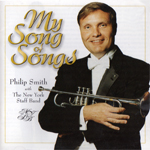
Arutunian
Sioux City Journal - Arutunian
Philharmonics Smith adds flair to Zhangs shuffled symphony
By Bruce R. Miller Journal staff writer
The two music worlds of Xian Zhang converged Saturday night when a member of the New York Philharmonic joined the Sioux City Symphony Orchestra.
For Siouxlanders, it was a chance to see how local performers match up to the ones she leads in New York (shes associate conductor of the New York orchestra). The answer: Pretty darn well.
On "Concerto for Trumpet and Orchestra" by Aleksander Arutunian, the local musicians gave guest performer Philip Smith the precise support hes used to back east. The woodwinds, in particular, complemented him well, making the piece as sharp as it needed to be. While there were moments when Smiths sounds were overwhelmed by the accompaniment, he soldiered on and enjoyed a stunning solo in the end.
As an encore, he brought two members of the Sioux City organization -- Bob Gibson and Scott Olson -- to join him on Leroy Andersons "Buglers Holiday," a familiar, jaunty piece thats a favorite among high school musicians. The three did a dandy job with it, suggesting Zhang could take a couple of Sioux City musicians with her to New York and let them guest with the Philharmonic.
After a week of workshops and performances, Smith said he liked being in Siouxland. "Why am I in New York?" he asked the crowd. "Even the Mets are losing tonight."
That blend of musicians wasnt the only change Zhang has made during the past year. She also has shuffled sections (the cellos, for example, are in a different spot) and given various members of the Sioux City orchestra opportunities to stand out.
Concertmaster Eunho Kim had a moment Saturday in Richard Strauss "Der Rosenkavalier Suite" and it was clear she is up to any challenge and quite able to solo elsewhere. In past concerts, weve gotten solo turns from other standouts -- a sign, perhaps, that Zhang has confidence in the group she inherited.
While Strauss waltz tended to get away from its players (there were more than 70 musicians involved), it had some clear moments and a couple of nice waltz segments.
Two Wagner pieces -- "Der Meistersinger Von Numberg: Prelude" and "Tristan und Isolde: Prelude un Liebstod" -- opened the concert. Both were handled well, even though they may not have been as flashy as the music that followed.
Zhang told the audience "Tristan und Isolde" was a revolutionary piece, introducing a chord that changed the way composers approached their music. Today, that "Tristan chord" turns up in just about every overly romantic movie soundtrack. It clearly sets a mood and justifies the inclusion of oboes in just about every lush Hollywood score.
While "Tristan and Isolde" was the title of the evenings concert, it might have been fitting to follow it with music that took advantage of Wagners risk-taking.
Instead, we got a little of this, a little of that and a whole lot of insight into the way the symphony conductor works.
